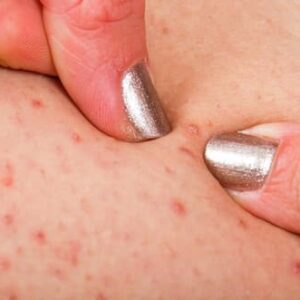
Eliminating black mold involves a structured process that encompasses identifying and rectifying the moisture source, eradicating the mold, and implementing preventive measures to hinder its reappearance. The following are steps to eradicate black mold:
- Prioritize Safety:
- Don protective gear, including an N95 respirator, goggles, and gloves, to shield against exposure to mold spores.
- Guarantee proper ventilation by opening windows and doors.
- Address the Moisture Source:
- Identify and rectify any water leaks or instances of excessive moisture, including roof leaks, plumbing issues, or heightened humidity levels.
- Utilize dehumidifiers to maintain indoor humidity below 60%.
- Isolate the Affected Area:
- Seal off the impacted area to prevent the dispersion of mold spores to other sections of the house. Employ plastic sheeting and tape to cover doors and vents.
- Dispose of Contaminated Materials:
- Discard porous materials that cannot undergo a thorough cleaning, such as drywall, insulation, and carpeting.
- Non-porous materials like glass, metal, and plastic can often be cleaned and salvaged.
- Utilize Mold-Killing Solutions:
- Employ a mold-killing solution to cleanse affected surfaces. Options include a mixture of water and detergent, hydrogen peroxide, vinegar, or a commercial mold cleaner.
- Employ a brush or sponge to scrub mold off surfaces.
- Bleach Application (if suitable):
- While bleach can effectively eliminate mold on non-porous surfaces, its preventive efficacy may be limited, and it can emit harmful fumes.
- If opting for bleach, create a mixture of one cup of bleach with one gallon of water and apply it to the affected area. Allow it to sit for a minimum of 15 minutes before rinsing.
- HEPA Vacuuming:
- Utilize a vacuum with a HEPA filter to clear away loose mold spores post-cleaning.
- Exercise caution to prevent the further dispersion of mold spores during the cleaning process.
- Ensure Adequate Ventilation:
- Enhance ventilation in the affected area by using fans and opening windows.
- Consider installing exhaust fans in bathrooms and kitchens to minimize humidity.
- Seal and Repaint:
- Following the cleaning process, apply mold-resistant primer and paint to impede mold growth on surfaces.
- Regular Monitoring for Recurrence:
- Conduct regular inspections of the area to detect any indications of mold resurgence.
- Promptly address any newly identified water leaks.
- Professional Assistance:
- In cases of extensive mold infestation or if health concerns related to mold exposure arise, contemplate engaging the services of a professional mold remediation service.
Bear in mind that the removal of black mold can pose challenges, and adhering to safety precautions is paramount. For sizable affected areas or health-related concerns, seeking guidance from professionals is advisable. Always adhere to safety guidelines and utilize appropriate protective equipment when dealing with mold.
How To Clean Black Mold
Cleaning black mold involves a systematic process of thoroughly sanitizing and disinfecting affected surfaces. Below is a detailed guide for safely cleaning black mold:
Safety Precautions:
Before commencing the cleaning process, adhere to essential safety measures:
- Protective Attire:
- Equip yourself with protective gear, including an N95 respirator, goggles, and gloves, to minimize exposure to mold spores.
- Adequate Ventilation:
- Ensure proper ventilation by opening windows and doors to facilitate the inflow of fresh air.
Cleaning Procedure:
- Identify and Resolve Moisture Source:
- Prioritize identifying and rectifying the moisture source that initiated mold growth, be it a leaking roof, plumbing issues, or elevated humidity. Addressing this source is critical to prevent mold recurrence.
- Isolate the Affected Area:
- Seal off the affected area to curb the dispersion of mold spores to other sections of the house. Utilize plastic sheeting and tape to cover doors and vents.
- Remove and Dispose of Contaminated Materials:
- Eliminate and responsibly discard porous materials, such as drywall, insulation, and carpeting, that cannot undergo thorough cleaning.
- Non-porous materials like glass, metal, and plastic can often be cleaned and salvaged.
- Prepare a Cleaning Solution:
- Create a mold-killing solution by mixing water and detergent, hydrogen peroxide, vinegar, or a commercial mold cleaner.
- Application of Cleaning Solution:
- Utilize a sponge, brush, or cloth to apply the cleaning solution to the affected surfaces.
- Thoroughly scrub the mold off the surfaces, employing a sprayer for larger areas if necessary.
- Rinse and Wipe Clean:
- Rinse the cleaned surfaces with water and wipe them dry, ensuring the complete removal of visible mold.
- Consider Bleach (if Suitable):
- While not universally required, a bleach solution (one cup of bleach to one gallon of water) can be applied to non-porous surfaces.
- Allow the bleach solution to sit for at least 15 minutes before thorough rinsing.
- HEPA Vacuuming:
- Use a vacuum cleaner with a HEPA filter to eliminate loose mold spores from the area.
- Exercise caution to prevent the inadvertent dispersion of mold spores during the vacuuming process.
- Proper Disposal of Cleaning Materials:
- Safely dispose of cleaning materials, such as cloths or sponges, used during the cleaning process.
- Preventive Measures:
- Apply a mold-resistant primer and paint to the sanitized surfaces to deter future mold growth.
- Address any lingering moisture issues to proactively prevent potential mold problems.
Note:
- For extensive mold infestations or health concerns, consulting with a professional mold remediation service is advisable.
- Adherence to safety guidelines and the use of appropriate protective equipment are imperative when dealing with black mold.
Emphasize the importance of preventing moisture to thwart mold growth. Regular inspections and swift action in response to leaks or water damage are effective strategies for averting black mold issues in the future.



